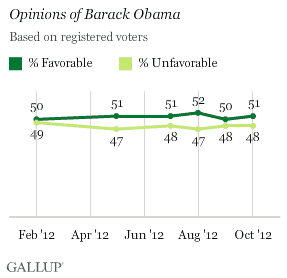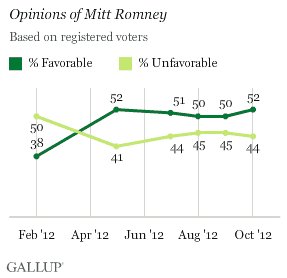PRINCETON, NJ -- Barack Obama and Mitt Romney will enter Tuesday's debate with similar favorable ratings from U.S. registered voters. In fact, among the electorate, the two presidential candidates' favorable ratings have been almost identical since May, after Romney clinched the Republican nomination.


Romney's unfavorable ratings among registered voters are slightly lower than Obama's, partly because Obama is better known, and more have an opinion -- positive or negative -- of the president. Romney's lower unfavorable ratings, and similar favorable ratings to Obama, give him a slightly better "net favorable" rating than Obama (+8 vs. +3). Romney's net favorable rating among registered voters has been no worse than tied with Obama's since May.
The latest results are based on an Oct. 10-11 USA Today/Gallup poll. It was conducted after the first presidential debate in Denver on Oct. 3 but before the second in Hempstead, N.Y., on Oct. 16.
The data suggest, at best, minimal change in each candidate's favorable ratings after the first debate. The lack of change is notable particularly for Obama, whose debate performance was widely panned, suggesting little damage to his image among the electorate, even though the race has tightened a little since then. It is also notable that Romney's favorable ratings did not improve much among voters even though he was widely considered the winner of that debate.
Previously, Gallup had reported candidate favorable ratings on the basis of all national adults, rather than only those registered to vote. On that basis, Obama's favorable ratings were generally higher than Romney's. For example, in a Sept. 24-27 USA Today/Gallup poll, 55% of all Americans had a favorable opinion of Obama and 47% of Romney, compared with favorable ratings of 50% for each among registered voters in the same poll. The differences in favorable ratings between national adults and registered voters indicate that non-registered voters are generally more positive toward Obama and less positive toward Romney.
The current poll did not measure favorable ratings among the national adult population.
Obama's and Romney's favorable ratings are also similar in 12 key election 2012 swing states, according to a separate Oct. 5-11 USA Today/Gallup poll conducted in Colorado, Florida, Iowa, Michigan, Nevada, New Hampshire, New Mexico, North Carolina, Ohio, Pennsylvania, Virginia, and Wisconsin. In those states, 52% of registered voters have a favorable opinion of Obama and 46% an unfavorable opinion. For Romney, the figures are 49% and 46%, respectively.
Implications
The presidential race is about as close as it can be with three weeks to go before Election Day. Obama and Romney are closely matched in voter preferences among both registered and likely voters. The candidates have similar favorable ratings among registered voters, and Americans are about as likely to approve as to disapprove of the job Obama is doing as president.
The final days of the long campaign transform it from a marathon into a sprint, and the remaining two candidate debates and the final weeks of in-person and over-the-airwaves campaigning will be important in helping determine the winner.
Survey Methods
Results for this USA Today/Gallup poll are based on telephone interviews conducted Oct. 10-11, 2012, on the Gallup Daily election tracking survey, with a random sample of 891 registered voters, aged 18 and older, living in all 50 U.S. states and the District of Columbia.
For results based on the total sample of registered voters, one can say with 95% confidence that the maximum margin of sampling error is ±4 percentage points.
Interviews are conducted with respondents on landline telephones and cellular phones, with interviews conducted in Spanish for respondents who are primarily Spanish-speaking. Each sample includes a minimum quota of 250 cell phone respondents and 250 landline respondents per 500 national adults, with additional minimum quotas among landline respondents by region. Landline telephone numbers are chosen at random among listed telephone numbers. Cell phone numbers are selected using random-digit-dial methods. Landline respondents are chosen at random within each household on the basis of which member had the most recent birthday.
Samples are weighted by gender, age, race, Hispanic ethnicity, education, region, adults in the household, population density, and phone status (cell phone only/landline only/both, cell phone mostly, and having an unlisted landline number). Demographic weighting targets are based on the March 2011 Current Population Survey figures for the aged 18 and older U.S. non-institutionalized population. All reported margins of sampling error include the computed design effects for weighting and sample design.
In addition to sampling error, question wording and practical difficulties in conducting surveys can introduce error or bias into the findings of public opinion polls.
For more details on Gallup's polling methodology, visit www.gallup.com.
